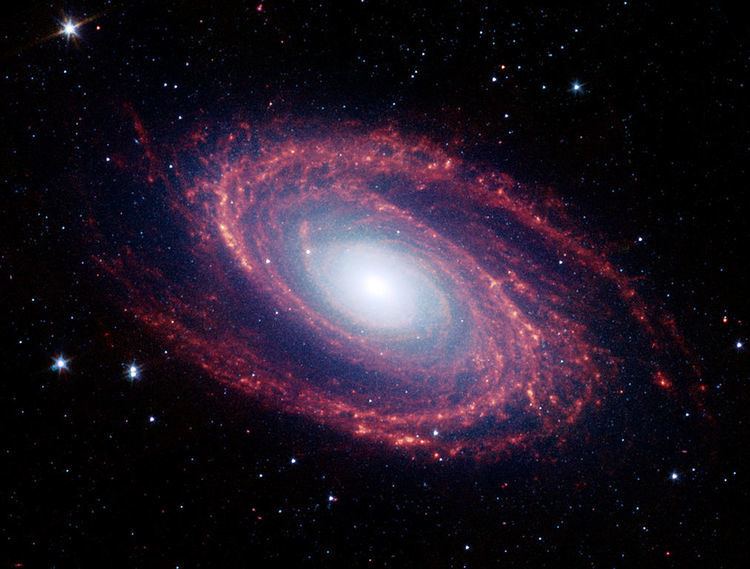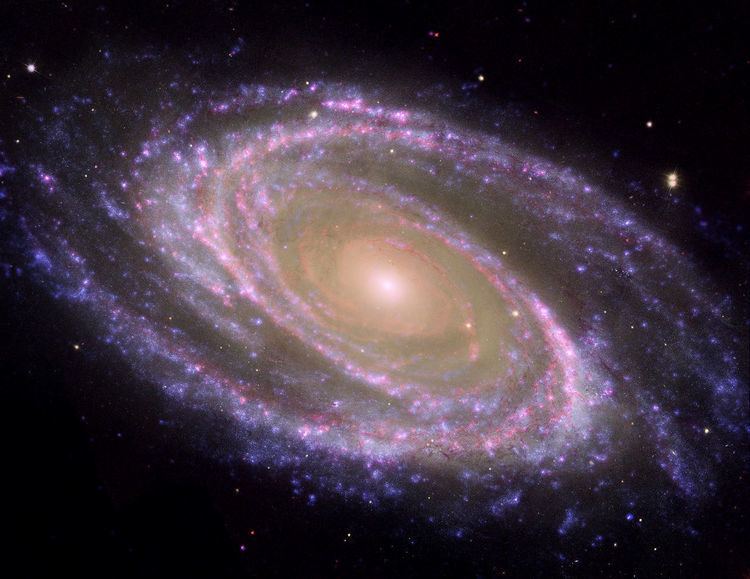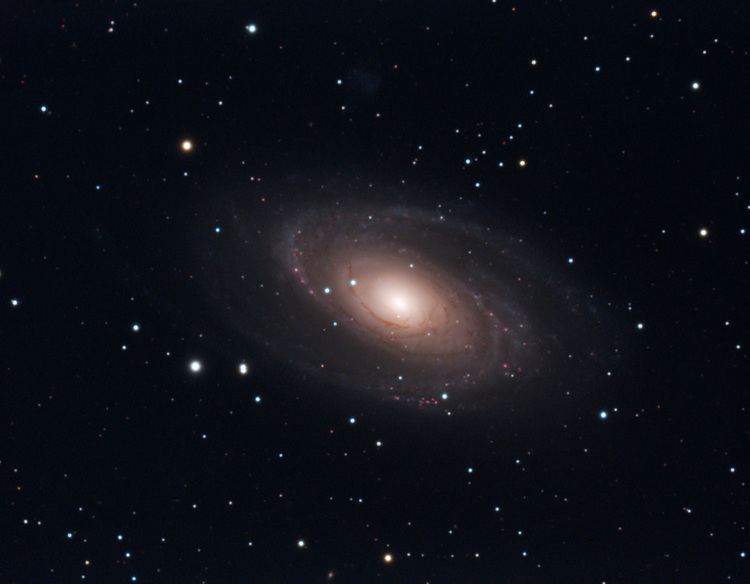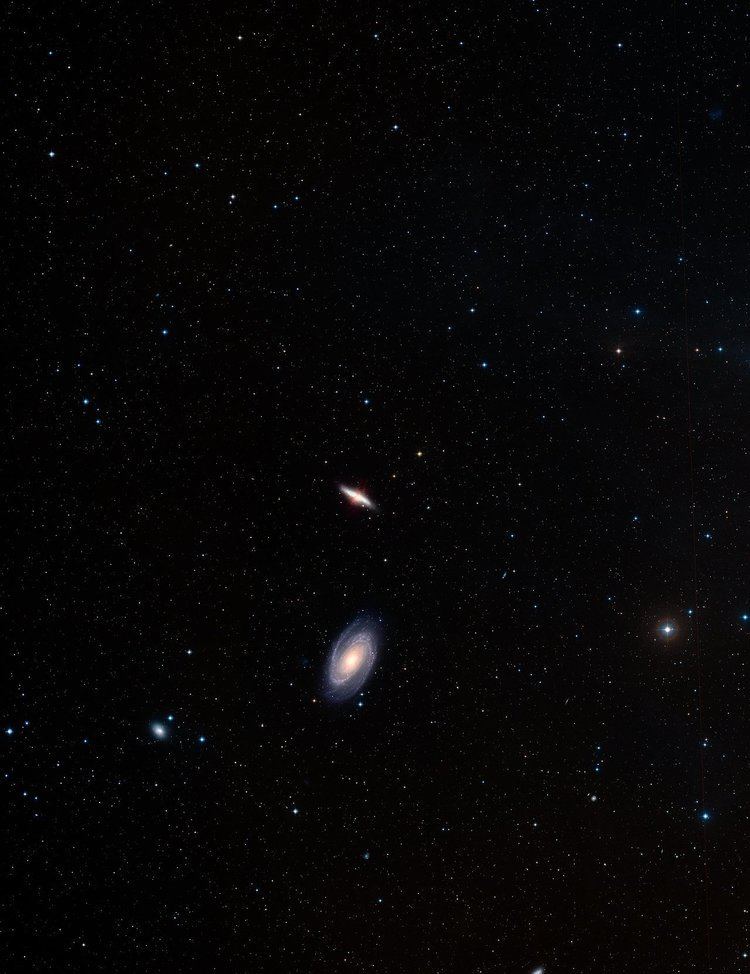Distance to Earth 11.74 million light years Discovered 1774 | Magnitude 6.94 Apparent magnitude (V) 6.94 | |
 | ||
Similar Messier 82, Whirlpool Galaxy, Pinwheel Galaxy, Messier 83, Triangulum Galaxy | ||
The bode s galaxy messier 81 ngc 3031 from the kleinfriesen observatory 48
Messier 81 (also known as NGC 3031 or Bode's Galaxy) is a spiral galaxy about 12 million light-years away in the constellation Ursa Major. Due to its proximity to Earth, large size and active galactic nucleus (which harbors a 70 million M☉ supermassive black hole), Messier 81 has been studied extensively by professional astronomers. The galaxy's large size and relatively high brightness also make it a popular target for amateur astronomers.
Contents
- The bode s galaxy messier 81 ngc 3031 from the kleinfriesen observatory 48
- Discovery
- Dust emission
- Supernova
- M81 Group
- Amateur astronomy
- References

Discovery

Messier 81 was first discovered by Johann Elert Bode on December 31, 1774. Consequently, the galaxy is sometimes referred to as "Bode's Galaxy". In 1779, Pierre Méchain and Charles Messier reidentified Bode's object, which was subsequently listed in the Messier Catalogue.
Dust emission

Most of the emission at infrared wavelengths originates from interstellar dust. This interstellar dust is found primarily within the galaxy's spiral arms, and it has been shown to be associated with star formation regions. The general explanation is that the hot, short-lived blue stars that are found within star formation regions are very effective at heating the dust and thus enhancing the infrared dust emission from these regions.
Supernova

Only one supernova has been detected in Messier 81. The supernova, named SN 1993J, was discovered on 28 March 1993 by F. García in Spain. At the time, it was the second brightest supernova observed in the 20th century. The spectral characteristics of the supernova changed over time. Initially, it looked more like a type II supernova (a supernova formed by the explosion of a giant star) with strong hydrogen spectral line emission, but later the hydrogen lines faded and strong helium spectral lines appeared, making the supernova look more like a type Ib. Moreover, the variations in SN 1993J's luminosity over time were not like the variations observed in other type II supernova but did resemble the variations observed in type Ib supernovae. Hence, the supernova has been classified as a type IIb, a transitory class between type II and type Ib. The scientific results from this supernova suggested that type Ib and Ic supernovae were actually formed through the explosions of giant stars through processes similar to those taking place in type II supernovae. The supernova was also used to estimate a distance of 8.5 ± 1.3 Mly (2.6 ± 0.4 Mpc) to Messier 81. As a local galaxy, the Central Bureau for Astronomical Telegrams (CBAT) tracks novae in M81 along with M31 and M33.
M81 Group
Messier 81 is the largest galaxy in the M81 Group, a group of 34 galaxies located in the constellation Ursa Major. At approximately 11.7 Mly (3.6 Mpc) from the Earth, it makes this group and the Local Group, containing the Milky Way, relative neighbors in the Virgo Supercluster.
Gravitational interactions of M81 with M82 and NGC 3077 have stripped hydrogen gas away from all three galaxies, forming gaseous filamentary structures in the group. Moreover, these interactions have allowed interstellar gas to fall into the centers of M82 and NGC 3077, leading to vigorous star formation or starburst activity there.
Amateur astronomy
Messier 81 is located approximately 10° northwest of Alpha Ursae Majoris along with several other galaxies in the Messier 81 Group. Messier 81 and Messier 82 can both be viewed easily using binoculars and small telescopes. The two objects are generally not observable to the unaided eye, although highly experienced amateur astronomers may be able to see Messier 81 under exceptional observing conditions with a very dark sky. Telescopes with apertures of 8 inches (20 cm) or larger are needed to distinguish structures in the galaxy. Its far northern declination makes it generally visible for observers in the northern hemisphere. It is not visible to most observers in the southern hemisphere, except those in a narrow latitude range immediately south of the equator.
